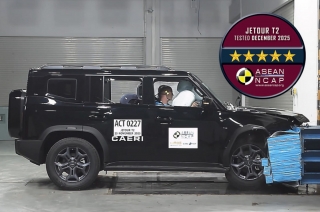
The AAA Foundation for Traffic Safety, a non-profit organization dedicated to saving lives by preventing traffic crashes and reducing injuries when crashes occur, has released a short study on the effects of driving assistance systems in order to prevent crashes and reduce injury in the event of an accident.
While the numbers given are United States estimates, they are still an alarming figure, as 6,950,000 vehicular accidents are said to occur around the USA annually. Out of that total, 3,034,000 of those accidents resulted in an injury of any of the passenger or other road users, and 32,702 resulted in at least one death.

The scope of the research brief also provides updated statistical estimates on the numbers of crashes, injuries, and deaths that could be theoretically addressed by equipping all cars, pickup trucks, trucks, vans, minivans, and SUVs with advanced driver assistance technologies. Such technologies include forward collision warning (FCW), automatic emergency braking (AEB), lane departure warning (LDW), lane keep assist (LKA), and blind spot monitoring (BSM). Convenience focused assistance systems such adaptive cruise control are not included in this study.

According to the study, the total potential number of accidents that could be prevented by applying all these technologies in total would be 40%, or 2,748,000 out of 6,950,000. 37% of injuries (1,128,000 out of the total) would also be prevented, and 29% (9,496) deaths would never occur. Broken down further, the usage of FCW and AEB only can result in a 14% drop in fatalities, plus a huge drop of 29% in injuries and 29% in crashes. This is because majority of accidents that happen where FCW and AEB is relevant is at city speeds or urban environments, and the technology works extremely well to mitigate potential accidents. While accidents and injuries with LDW, LKA, and BSM can be prevented in the single digit percentages, the deaths that could be stopped are at 14%, as the speeds where these technologies come into play are usually much higher (freeway, multiple lanes).

You can click this link to go into more detail on the study, and have your fill of charts and numbers. The study calls for the implementation of all types of driver assistance systems in all cars in the future, and, as the years go by and the technology gets more accessible, there’s a big chance that even the smallest passenger car will be much safer. While assistance systems are a great feature to have, it still comes down to driver attentiveness and skill, as most accidents are usually human error to begin with. Proper licensing, more time on the road, and adherence to road rules and regulations are all factors, but that’s a whole different story.
Latest News
-
No physical license? LTO says LTMS e-driver’s license is valid for traffic stops / News
The Land Transportation Office reminds drivers that the e-license via LTMS is a valid substitute for inspections.
-
JETOUR’s T2 SUV nets five-star ASEAN NCAP safety rating / News
JETOUR’s rugged T2 shines in ASEAN NCAP tests, achieving a five-star safety rating with an impressive 86.5-point score.
-
Hongqi’s AWD Flagship EVs shine in real-world efficiency test at DOE Eco Run / News
The EHS7, EH7, and EHS9 represented Hongqi at the 2025 DOE Eco Run, returning impressive real-world efficiency results.
Popular Articles
-
Electric Vehicles in the Philippines for under P1 million
Jerome Tresvalles · Aug 19, 2025
-
Top 3 Cars For Every Lifestyle—What Cars Are Right For You? | Behind a Desk
Caco Tirona · Apr 24, 2024
-
5 Tips to Maximize Fuel Efficiency
Jerome Tresvalles · Sep 09, 2024
-
Five driving habits that are draining your fuel tank
Jerome Tresvalles · Jun 24, 2025
-
Can engine braking harm your engine?
Jerome Tresvalles · Sep 11, 2025
-
Do electric cars even need maintenance?
Jerome Tresvalles · Oct 23, 2024
-
Best vehicles for an active outdoor lifestyle
Shaynah Miranda · Jul 25, 2024
-
How to drive different types of vehicle transmissions
May 23, 2024
-
5 easy ways to keep your car interior clean
Allysa Mae Zulueta · Nov 15, 2021
-
How to survive Metro Manila traffic
Earl Lee · Aug 16, 2022



